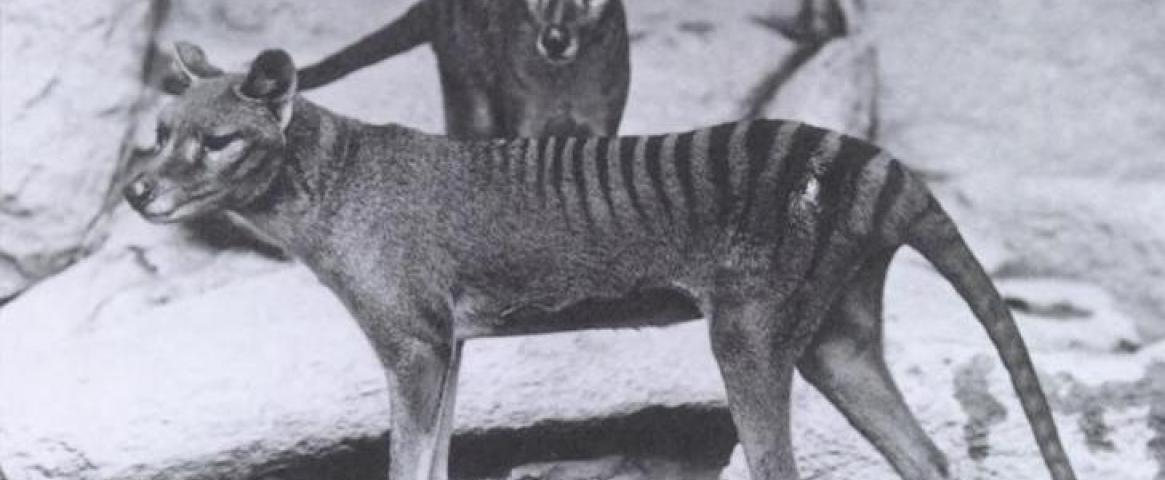By Jade Lin. Mentored and edited by Alka Tripathy-Lang.
In conservation biology, there is the long-standing notion that extinction is forever.
In 2021, the United States Fish and Wildlife Service declared 22 animals and one plant extinct. But if scientists could recreate those species using technology, would that diminish your motivation to protect them in the first place? Genetically engineering the genome of a living species to resemble that of an extinct relative — called de-extinction — raises such questions.
In a poster presentation at the 2022 AAAS conference, Arizona State University doctoral student Risa Schnebly discussed the potentially problematic impacts surrounding how scientists and science communicators talk about de-extinction. In her literature review on de-extinction, she found that the “extraordinarily optimistic messaging strategies” used by de-extinction proponents are misleading and could change how people think about nature.
De-extinction researchers tell a story that emphasizes technological solutions, instead of prophesying impending mass extinction via doom and gloom messaging. De-extinction proponents aim to combat the rapid decline of biodiversity by “resurrecting” extinct species and returning them to the wild. Notable projects include reconstructing the woolly mammoth from the genome of the Asian Elephant and reengineering the Tasmanian tiger, a marsupial once found in Australia, Tasmania, and New Guinea, from the genes of the numbat.
However, critics of de-extinction are wary of the unintended consequences that may arise from reintroducing an extinct species into an ecosystem that has evolved without them. Many worry that de-extinction campaigns may funnel away resources and funding from conservation efforts for living endangered species. And, de-extinction efforts, if successful, would have little effect on the staggering rate at which species are being lost.
“This idea of extinction being reversible tends to boost misleadingly positive emotions, while doing away with all of these actually really useful negative ones,” said Schnebly. Ongoing extinctions seem less sad and less important, she said, because of false optimism around our ability to combat extinction with technology. “It … motivates us to put all of our hope into technological fixes.” Though de-extinction could prove a useful conservation tool in the right circumstances, technology alone cannot solve the biodiversity crisis.
The overhype of de-extinction technology stems from the critique that traditional conservation messaging tends to be too negative. As Stewart Brand, the founder of Revive and Restore, which started the project to de-extinct the wooly mammoth, wrote in this essay for Aeon: “Viewing every conservation issue through the lens of extinction threat is simplistic and usually irrelevant. Worse, it introduces an emotional charge that makes the problem seem cosmic and overwhelming rather than local and solvable.”
But Schnebly argued that the optimism around de-extinction swings too far in the other direction.
Positive emotions like hope and awe have long been used to engage people in conservation, but “de-extinction tends to hijack these emotions and redirect our awe for nature into awe for technology,” said Schnebly.
The narratives around de-extinction also tend to erase negative emotions that may motivate people to care about conservation. “Negative emotions, like guilt or grief or fear can become really overwhelming,” said Schnebly. “But if we balance them out with messages of efficacy and empowerment, then [negative emotions] can become really powerful motivators.”
However, the story of reintroducing extinct species remains a compelling narrative. In a survey of 52 freely available web articles about de-extinction, Schnebly found a majority reinforce the idea that extinction is reversible by using misleading language such as “revive,” “resurrect,” or “bring back the dead.” This type of science makes headlines and excites people.
To this point, Schnebly recommended that scientists and science communicators be thoughtful about the language they use to discuss extinction and other environmental problems. “I think it’s … important to embrace whatever emotions all of these different topics bring up,” she said. “Neither this hyper-optimistic narrative put forth by de-extinction, nor the more traditionally negative one encountered in conservation is a perfect story to tell.” By combining the useful elements of each movement, she said, people can tell more nuanced, honest and empowering stories about the world.
Rather than overly emphasizing positivity or negativity, communicators should focus on giving people a sense of agency, said Schnebly. “Getting people to feel like their own actions matter is a really important first step to take in motivating people to care about biodiversity everywhere.”
Jade Lin is a graduate student pursuing a master’s degree in science writing at Johns Hopkins University. You can follow her on Twitter @JLinSci or email her at jlin150@jhu.edu.
Image: Scientists are exploring ways to recreate the extinct Tasmanian tiger (also known as the thylacine) using DNA from the closely related numbat. Credit: Baker; E.J. Keller., Public domain, via Wikimedia Commons

